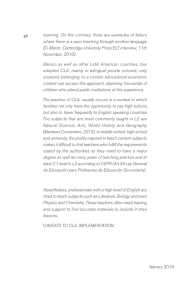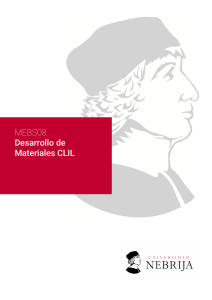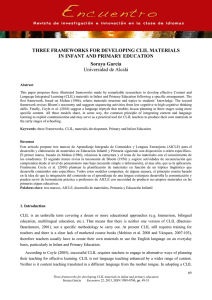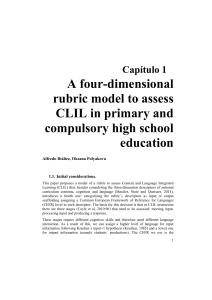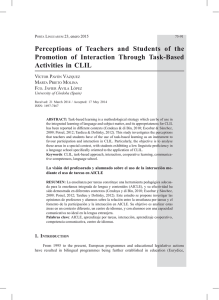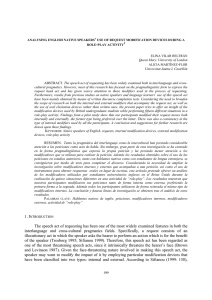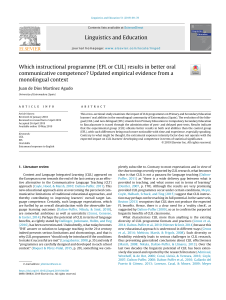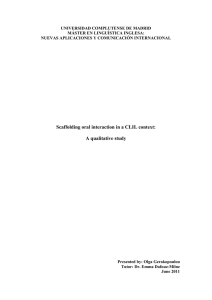Christiane Dalton
Anuncio
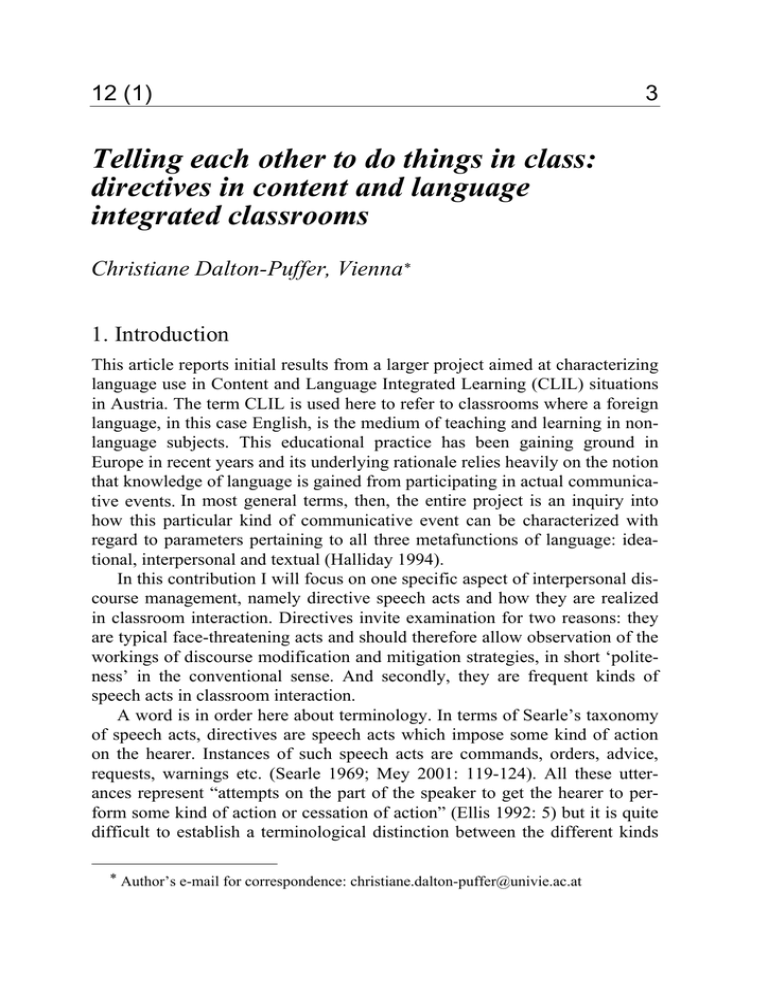
12 (1) 3 Telling each other to do things in class: directives in content and language integrated classrooms Christiane Dalton-Puffer, Vienna* 1. Introduction This article reports initial results from a larger project aimed at characterizing language use in Content and Language Integrated Learning (CLIL) situations in Austria. The term CLIL is used here to refer to classrooms where a foreign language, in this case English, is the medium of teaching and learning in nonlanguage subjects. This educational practice has been gaining ground in Europe in recent years and its underlying rationale relies heavily on the notion that knowledge of language is gained from participating in actual communicative events. In most general terms, then, the entire project is an inquiry into how this particular kind of communicative event can be characterized with regard to parameters pertaining to all three metafunctions of language: ideational, interpersonal and textual (Halliday 1994). In this contribution I will focus on one specific aspect of interpersonal discourse management, namely directive speech acts and how they are realized in classroom interaction. Directives invite examination for two reasons: they are typical face-threatening acts and should therefore allow observation of the workings of discourse modification and mitigation strategies, in short ‘politeness’ in the conventional sense. And secondly, they are frequent kinds of speech acts in classroom interaction. A word is in order here about terminology. In terms of Searle’s taxonomy of speech acts, directives are speech acts which impose some kind of action on the hearer. Instances of such speech acts are commands, orders, advice, requests, warnings etc. (Searle 1969; Mey 2001: 119-124). All these utterances represent “attempts on the part of the speaker to get the hearer to perform some kind of action or cessation of action” (Ellis 1992: 5) but it is quite difficult to establish a terminological distinction between the different kinds * Author’s e-mail for correspondence: [email protected] 4 VIEWS of directives that goes beyond their general lexical meaning. On the one hand, it is said that what makes a request a request and a command a command are the general conditions of interaction whereas their specific realization is then a matter of choice, for instance in terms of directness.1 In reality, however, the conditions and realisations are impossible to tease apart. This may explain why, in the pragmatics literature, the term request is frequently used as an umbrella term and quasi-synonym of directive (e.g. Ellis 1992; House and Kasper 1989b). In some instances in the present text this practice is also observed, mainly for stylistic reasons. As this study deals with speech acts in foreign language data, research on interlanguage pragmatics is of particular relevance for it. All of the studies reviewed appear to suggest that realizations of directives in CLIL classroom discourse are likely to be rather limited not only in terms of who gets to utter them but also in terms of the linguistic choices used to encode them. After a brief presentation of the analytical framework used and its theoretical and methodological background, the main focus will be on a description of how directives are actually realized in a sample of upper secondary CLIL classrooms in Austria. It turns out that some of the predictions derivable from the descriptive model are not borne out by the data. 2. Directives and politeness in the classroom: literature review In an early study, Lörscher & Schulze (1988) look at issues of politeness in the discourse of foreign language classrooms in Germany. They base their analysis on Brown and Levinson’s (1987) theory of politeness, the implication being that realizations of speech acts which are indirect and off record are more polite than those which are direct and bald on record. Lörscher and Schulze find the latter to be heavily dominant in the EFL classrooms they investigate (though it is never mentioned just how many classrooms they look at) and they consequently conclude that there is a general lack of politeness. An acquisitional view is taken by R. Ellis (1992) in his study of two learners’ requests. In this longitudinal developmental study of naturalistic classroom discourse, Ellis looks at over 400 requests produced by two child learners of English as a second language over a period of 15 and 21 months. Ellis considers it crucial that “the opportunity to communicate a varied set of illocutionary acts may be important for successful L2 acquisition” (1992: 20). 1 E.g. Widdowson personal communication April 2003. 12 (1) 5 This, it turns out, is also the limiting condition on the acquisition process reported in Ellis’s study: while both learners progressed in their acquisition of English requests, neither of them developed the full range of request types or a broad linguistic repertoire for their realization. Ellis attributes this to the kinds of communicative needs which arose in the school setting, and to the fact that the classroom offers little opportunity to perform requests that place a heavy imposition on a socially distant addressee. One study which looks specifically at teachers’ directives in foreign language classrooms is reported by Falsgraf and Majors (1995). The authors examine directives as indices of student-teacher status relationships, finding significant differences between Japanese (both as a foreign and as a native language) and English as a medium of instruction. Teacher directives in those elementary classrooms where Japanese was the medium of instruction were significantly more direct than in the English medium ones. They conclude that the high level of directness reflects the status differential between students and teachers but also characterizes the relationship between teacher and young students as close and informal (cf. Kasper 2001: 38). A situational context which closely resembles the one investigated in the present study is examined by Nikula (2002). Her study looks for indicators of pragmatic awareness in the classroom language of two Finnish teachers teaching an EFL lesson and a “maths through the medium of English” lesson. In other words, this is also a study of CLIL classroom language in a European context. Although her analysis does not focus specifically on directives, these speech acts figure prominently in the study since here as in other classrooms teachers simply tend to ask students “to do things in class” (Nikula 2002). Furthermore, Nikula finds that no matter how large (L1) or small (L2) the modifier repertoire, modifiers are simply not very much in use in these classrooms. Most of the directives and other teacher utterances in her data are direct and Nikula describes them as “abrupt”. In section 4 it will be shown that the Austrian data parallel some, but not all of Nikula’s Finnish findings. I regard this as an indicator that the influence of L1 discourse culture on the production and acquisition of target language speech acts should not be underestimated. In how far the Finnish teachers’ non-use of modifying elements can be unequivocally interpreted as a lack of pragmatic awareness, depends very much on how much one wishes to buy into politeness theory à la Brown and Levinson (cf. the parallel conclusions arrived at by Lörscher and Schulze 1988). It is possible that pragmatic awareness in a concrete situation might well rest in the non-use of modifying elements rather than vice versa. 6 VIEWS 3. A framework for analysis: Theoretical and methodological background Confronted with the highly complex data which naturalistic classroom discourse represents, it is necessary to adopt or adapt a framework for their analysis. Brown and Levinson’s theory of politeness (1978; 1987) has played a significant role in researching interlanguage and cross-cultural pragmatics. It has been rightly criticized on various accounts (for overviews see Meier 1995; Trosborg 1995: 28-29) and the discipline is currently reconsidering the basic theoretical issues in the light of more comprehensive frameworks of social interaction (e.g. cross-cultural communication) (Meier 2003) However, the discussion has not reached a stage where ready operationalisations are at hand. It therefore seems justifiable to me to use concepts and operationalisations developed by or on the basis of Brown and Levinson’s theory for the purpose of data analysis, even though it cannot be expected that they will give a satisfactory explanation for all the phenomena observed. According to Brown and Levinson (1987), social interaction is conditioned by three important parameters: the distribution of social power, the degree of social distance, and the degree of imposition a particular pragmatic act is thought to have on the recipient. These three factors (power (P), distance (D), the individual ranking of the particular imposition (R)) play a central role in co-determining which kind of politeness strategy and thereby what degree of (in)directness a speaker will use in a given situation (cf. Brown and Levinson 1978: 81). In other words, speakers are thought to use the formal resources of language (tenses, modals, lexical phrases etc.) to achieve different degrees of (in)directness in order to symbolically represent the constraints which the P-D-R parameters impose on their behaviour. With regard to English language directives, previous research has provided inventories of linguistic resources (external and internal request modification) and has categorized them in terms of how much (in)directness they convey (cf. Trosborg 1995, House and Kasper 1981, 1987; Blum-Kulka and Olshtain 1984; and Faerch and Kasper 1989). For reasons of space I reserve the details for the descriptive section.2 The basic notion, then, is the following: based on their judgement of the parameters Power, Distance and Imposition, speakers choose a particular directness level with its concomitant linguistic realization. Once this has been accomplished, the speaker can then choose softeners or intensifiers from a 2 For a full discussion of the analytic framework see Dalton-Puffer (2003). 12 (1) 7 repertoire of internal and external request modification strategies in order to fine-tune the politeness value of this specific directive. A serious problem in this undertaking is of course that it operates on the assumption of form-function continuity. That is, the analyst assumes that (all other things being equal) every time a certain form is observed, it will have the same function as the times before. This is only an assumption but a useful one and the problem it creates is one we will have to live with. 4. Formulating hypotheses In order to sharpen the focus for data analysis, one may use the Brown/Levinson model to formulate some expectations. Given the research reported in section 2 there is little to dissuade one from believing that the classrooms in this study will show the same characteristics as the other classrooms investigated: the overwhelming number of directive speech-acts will come from the teachers and their realization is expected to lie on the “direct” end of the directness scale with little additional discourse modification. Making more specific reference to the power-distance-imposition parameters of the Brown/Levinson model of politeness the following predictions can be formulated: a. power: the interlocutors represent a hierarchy differential, occupying different status positions within the institution. Since most directives are uttered by the [+power] participants, this will create a tendency for directives to be more rather than less direct. b. distance: the interlocutors are usually familiars. They have frequently known each other for several years, meeting regularly approximately twice per week. This is a constellation which favors more direct strategies and disfavors the use of heavy discourse modification. c. imposition: the transfer of information is the socially sanctioned purpose of the institution, which is “school”. Therefore requests which are in support of this institutional goal represent low imposition by definition. This likewise disfavors use of discourse modification and indirectness. As we can see, all three factors converge in one direction: directives in CLIL classroom discourse are likely direct, and will evidence little discourse modification. If this hypothesis is supported by the data, this means that there is a severe limitation on the kind of requesting behavior which can be learned in and from these classrooms, passively or actively. Hall even suggests that the conditions under which discourse progresses in the classroom is so different 8 VIEWS from non-educational contexts that “extended participation in such a practice could facilitate the development of L2 interactional incompetence” (Hall 1995: 55). 5. Data analysis 5.1 The Study The data analyzed for this article were recorded in secondary schools in Austria in the 2001/2002 academic year. They are part of a larger body of naturalistic classroom data comprising a total of 42 CLIL lessons from lower and upper secondary schools (students aged 11-19). The lessons were audiorecorded in the presence of the researcher, who also took field-notes. Additional lessons were observed without making audio-recordings. The examples in this article are taken from the transcripts of six upper secondary lessons, where English was used as the medium of learning for subjects other than “English as a Foreign Language”. The six lessons represent the subjects of history, music, tourism management, business studies, and accounting and were taught by six different teachers (male and female). The age of the students ranges from 16-19 years. Except for one teacher, all participants are non-native speakers of English; most have Austrian German as their L1. For some students Austrian German is their second language. The teachers vary in their formal English background; some have a university degree in English Studies, others hold degrees in other subjects. It was decided to focus on upper secondary data because the student population represented in the larger data-set spans ages 11-19, that is from late childhood via adolescence to young adulthood. Since the interactional status accorded to people in society changes considerably over this period and has a direct impact on the issues studied here, it was decided to narrow the focus to late adolescence. Classrooms are a prototypical one-vs.-many participant situation, combining a clear hierarchical difference between participants with an uneven distribution of speaking rights. These classrooms are no exception and the overwhelming majority of directives are consequently uttered by the teachers.3 In the following I will therefore concentrate on teacher directives with occasional observations on the requesting behavior of students. 3 No exact quantification of teacher vs. students requests has been undertaken as the addi- tional insight gained did not warrant the effort required. 12 (1) 9 5.2 Trading information In the analysis of the present data it turned out that the question of what is requested by and from the interactants, i.e. “object of the request”, is a nonnegligible factor. In this I follow Halliday’s key distinctions in interpersonal communication between giving or demanding either goods and services or information. (Halliday 1994: 354f). As far as I am aware pragmatics has made no systematic distinction between different kinds of request objects (demands for physical vs. verbal action) on the superordinate theoretical level. Rather, it is thought that within a given social situation the different objects of requests will take on a differential value with regard to, for instance, the degree of imposition and consequent face-threat accorded to them by the interactants. And it has therefore not given them a separate role in the interplay of factors which determine the realization of speech acts. In the educational context we are studying here, we may assume that ‘curricular content’ is a kind of good which has central status within the institution different from other symbolic or physical goods. After all, schools are concerned with the transfer of information unlike most other institutions. Thus, from the point of view of the teacher as its representative, offering curricular content and demanding information about the students’ states of mind regarding elements of curricular content are those speech functions which are completely sanctioned by her/his institutional role. It is thus not surprising that demands for information appear in the data in their canonical form as questions. The examples (1) give a small sample of such familiar teacher questions from the current data. (1) Classroom examples of “demand for information” and why were they called colonies? yes, what does inherit mean? what kind of city do you know about in the east of America. what is it in german. how could you measure energy use. what did the trenches remind you of. In the institutional game of information transfer, then, questions are strongly associated with the core purpose of teaching and learning, which seems to bestow upon them a quality of being ‘unmarked’ and officially sanctioned types of utterances. This may explain why students mainly either respond to teacher questions or pose questions themselves. What is intriguing is that the format of question is chosen also if the student has other interactive aims altogether. Interestingly, such occasions are frequently flagged by the occurrence of external modification, more specifically the occurrence of so- 10 VIEWS called preparators (cf. Table 2, p.14). In example (3), for instance, the teacher has been keeping the topic on the financial rights and obligations in marriages in ancient Athens, while the student question in line 4 actually steers the talk towards the legal possibilities for divorce. (2) 1 T ((dowry)) this is the money that goes to the ... husband ... a:nd the husband administers it, yeah? he can do with it what he likes, but in case of divorce? (pause) the money goes back to 2 S the father 3 T and iffah the father has meanwhile died, it goes to the brother or even the eldest son, whoever is the guardian of the woman, ... yeah? 4 S i have a question: could the wife ahm ah the woman say she w- she wants to be divorced? In the following example the student’s purpose is even further removed from being a “demand for information”. (3) 1 Sm ich wollte was fragen (I wanted to ask something) 2 TG ja bitte 3 Sm da is ein widerspruchh, dass er zuerst sagt ah das is eben nich also das is- (yes please) für gutheissen kann, dass die rockmusik in den 60er jahren in das musikalische theater einbricht und dann meint er, dass man nicht herumexperimentiert. ich mein ich denke wenn die rockmusik neu ist, ist das schon irgendwie rumexperimentieren. (there’s a contradiction. that he says at first ah it is not err it is – (he) cant accept that rock-music makes inroads into the musical in the 1960s, and then he says that people don’t experiment. i mean i think if rock music is new, that is experimenting of sorts.) Example (3) may look like a prefaced question but turns out to be a statement. Presumably this format is chosen by the student because posing questions is the officially sanctioned speech act for students during the instructional part of the lesson. It supports his bid for a turn (conventionally done by non-linguistic signs like raising a hand); also, the student may consider it less risky to announce a question rather than a contradiction (cf. Simpson 2003). 12 (1) 11 5.3 Trading goods and services Although the institutional core of formal education is conceived of as the transmission and/or co-construction of knowledge, the lesson as the central speech event where the official purpose of the institution is being enacted also consists of parts where the “knowledge business” is physically and verbally facilitated through regulative behavior (cf. Ellis 1992, Christie 2000). These are the instances where requests for goods and services come into play. In the scheme proposed by Halliday (1994: 354f) the canonical realization of this speech function are commands expressed by the imperative. Contrary to demands for information, however, where canonical realizations (i.e. questions) are heavily dominant, classroom requests for anything other than curricular content exhibit a wide variety of realizations. In order to view the matter more systematically, the realization types found in the data have been mapped onto a scale of directness (cf. Trosborg 1995: 205). Table 1. Austrian CLIL data mapped onto the request directness scale Strategy I. Indirect Request 1 Hints (mild) CLIL example i am not really good prepared for II. Conventionally indirect (Hearer based conditions) 2 Ability can you pass them round for us? Willingness would you like to continue? Permission can i go to the toilet? 3 Suggestory formulae xxx n.a.(How about lending me your car?) III. Conventionally indirect (Speaker based conditions) 4 Wishes what i would like you to do later is.... 5 Desires/Needs i want you to write a little heading. IV. Direct requests 6 Obligation 7 Performatives 8 Imperatives Elliptical phrases you must return it according to your catalog number. xxx n.a (I ask you to lend me your car) think about that question. Daniel, Andreas. It can be seen that the directive realizations found in the data span the entire spectrum of the directness scale from most direct to most indirect. Note that two cells in the table lack examples from the current data. These cells concern the strategies “performatives” and “suggestory” formulae. The absence of performatives may very well not be an idiosyncrasy of the present data. Elllis (1992: 19), too, found no performatives or hedged performatives in his naturalistic classroom data. He surmises that they may be rare in naturalistic settings and the present data support his view. Similar results are reported by Koester (2002), who finds that performatives are strongly dis- 12 VIEWS preferred in her corpus of workplace interaction. In unequal encounters such direct strategies were used only in critical situations when dominant speakers wished to assert their authority and therefore were rare occurrences overall. Incorporating quantitative considerations into the interpretation of Table 1 one makes the startling discovery that it is actually quite difficult to find examples of direct teacher requests (category IV). The following is an exhaustive list of direct teacher requests (i.e. commands) for goods or services in six upper secondary CLIL lessons (seven classroom hours): (4) Direct teacher requests in six CLIL lessons 1 T5 okay. now i think it’s too late. sit down, you will continue next lesson. 1 T1 think about that question for 30 seconds 1 T3 okay ... go on .. that’s all clear anyway. 1 T11 you must return it according to your catalog number, so that you’re not in trouble 1 T11 keep this very carefully, we need it later on. 1 T32 david, axel4. ((elliptic for ‘be quiet’)) That is to say that during seven classroom hours these teachers go bald on record with a request only six times. The vast majority of teacher requests use indirectness strategies which, according to the framework of analysis employed, are unexpected given the teachers’ hierarchical position and social role. Here are some examples of the most common and hence typical teacher directives in the data. (5) Typical teacher directives in Austrian CLIL data 1 T1 1 T3 so can you do that please. can you take out these sheets of paper the Acropolis .. andah you are going to get .. the same .. picture ah as a photocopy 2 Sf thanks ... i need two 3 T3 yeah .. okay .. maybe .. silvia could pass it (?) around 4 ((rustling and handing on of papers)) 5 T3 can you pass them round for us 1 T3 let‘s look at the social structure 1 T3 and i want you to write a little heading ‚legal status of women‘ ...and tell me what you think ...yeah? 1 T3 yeah. can you stop it. could you please read now. 4 Participants’ names have been anonymized. 12 (1) 13 1 T5 at the beginning. very good. would you like to do it please? 1 T5 markus could you please be silent 1 T5 would you like to continue? 1 T11 could you please have a look at the new books now 1 T11 can you please turn to your neighbour 1 what i would like you to do later is ah.. try to imagine you meet someone who doesn’t know the book 1 T11 let’s have a look at the economy first 1 T11 good, could you think about three factors that changed for women dramatically in this period 1 ((it’s recap time at the start of the lesson)) 2 T35 okay. so...could anybody please just quickly tell me the three ratios we are talking about 1 T35 would you please continue, martina 1 T35 anna, would you please... 1 T35 okay, could you interpret the numbers? 1 T35 so could you repeat richard 1 T32 i’d like to start with ah some kind of a brainstorming activity today (.... ) but first of all let’s have reports on these different topics 1 T32 may i ask a question in between? 1 T32 have you got a piece of chalk somewhere? 1 T32 could you give us an idea of the location. i don’t know wether all of us are so familiar with... 1 T32 okay then well let’s have one of the other reports 1 T32 may i interrupt you? It is obvious that teacher directives in these classrooms typically exhibit linguistic strategies classified as “conventionally indirect” in terms of the directness scale employed. Both, speaker-based and hearer-based conditions are represented, with a clear majority being hearer-based, i.e. the more indirect, conditions. Later in this section the formal aspects of directive realization will be discussed further but first attention needs to be turned to the use of modification strategies. From the presumably exhaustive taxonomy (for English) of internal and external modification given by Trosborg (1995: 209-219), only a limited number of options are actually realized in the present data. The external modification types evidenced in the data are assembled in Table 2. Table 2. External modification types occurring in Austrian CLIL data 14 VIEWS Strategy disarmers hesitation give supportive reasons preparators Example/Explanation make requestee favorably disposed towards requester erm, ahm .... if request seems justified, then H probably more willing to comply. preparing the discursive ground for the request by openly announcing it This list of modification types, it should be pointed out, reflects a very small number of tokens in the data. The six lessons yield three examples by teachers and two by students (the latter both realized in German). As an explanation for the rarity of external modification I suggest looking at its function in interaction. External modification serves the purpose of opening up the discourse space in order to enter into an interaction with someone with whom one has not been interacting immediately before. The classroom rarely requires this strategy because essentially once the lesson has started, the discourse is considered opened. One example of an externally modified teacher request comes from a lesson where textbooks were handed out for the whole school-year in the understanding that the students were to return their personal copy to the school at the end of the year. (6) 1 2 ((handing out textbooks at beginning of term; it is the start of the lesson)) T11 manuela, i have special challenge for you, could you start from number fourteen please because i think i have..... It seems that the somewhat tiresome administrative procedure combined with the ‘imposition’ that the students take responsibility for keeping track of their books, prompted the teacher to put in extra linguistic “work” (by using a preparator and giving a supportive reason) towards getting the students to cooperate. The last aspect of teacher request realization to be discussed within the present framework is internal modification. Table 3 provides an overview of the types of modifiers evidenced by the present data. Table 3. Internal modification types occurring in Austrian CLIL data syntactic downgraders question instead of statement past tense/conditional lexical/phrasal downgraders politeness marker downtoners, minimizers hedges can you pass this round? could/would you pass this round? please just, quite, quickly, little kind of, sort of 12 (1) 15 Comparing this to the full list of choices available in English (Trosborg 1995: 209-215), the array of choices which are realized in the CLIL data appears limited. The easiest conclusion to draw would be that these limitations are actually due to the limited language competence of the speakers involved. However, this might be too easy a solution, since it has to be kept in mind that the full taxonomy was derived from a much larger number of social situations than classroom interaction.5 Looking at the naturally occurring data (compare examples (5) of typical teacher requests), we also find that the request realizations with their combinations of different kinds of strategies look considerably more varied than the table above would lead one to believe. Generalizing from the individual realizations, we find a prevalence of syntactic downgraders, that is modal verbs, especially those expressing wishes, willingness, ability and possibility, occurring in interrogative clauses. This is frequently combined with the strategy of shifting the deictic center away from the speaker (mostly the teacher) towards the hearer(s) or towards an inclusive we. 5.4 Personal and cultural styles Over and beyond the wide repertoire of formal realizations of directives shown by the data, a quantitative check of the transcripts reveals clusters of linguistic choices favored by individual speakers, which may actually indicate individual interactional styles. In other words, different teachers may interpret the social constellation within the classroom in subtly different ways. In order to follow up this particular question in any depth it would of course be necessary to make systematic comparisons with lessons conducted by these teachers in German. Only then might we begin to untangle the web of interference between the several interrelated factors which appear to be involved: “personal communicative style”, “cultural style”, “personal pedagogical philosophy”, “L2 persona” and “degree of language proficiency”. The following observations will illustrate this. The one teacher who is also a native speaker of American English consistently uses less heavily modified directives than her native Austrian colleagues. Rather than jumping to the conclusion that this person is “more direct” or even “less polite”, it might be more to the point that this difference reflects a different cultural pattern with regard to how teachers construct their 5 If one wanted to measure the CLIL data against a putative native speaker norm – this being an undertaking of debatable validity in the first place – it would have to be a norm which is based on classroom interaction only and that, to my knowledge, is not available. 16 VIEWS relationship with students (One might regard this as a combination of the factors “cultural style” and “personal pedagogical philosophy”). It has been pointed out to me that the North American cultural script of the studentteacher relationship is one of collegiality, which would entail a less hierarchical relationship than that written into the Austrian cultural script and would thus require less discourse modification, which is what is in evidence in the speech of this one teacher.6 Conversely, the Austrian teachers use a considerably larger amount of request modification and indirectness – I will henceforth use the term request cushioning as an ad-hoc cover-term for both. Two scenarios suggest themselves for explanation, and while they are somewhat contradictory, they are not mutually exclusive. Firstly, employing the concepts of power, familiarity and imposition provided by the framework of analysis used (Brown and Levinson 1987; cf. section 3), one might say that the degree of request cushioning observed may be due to the fact that the Austrian teachers see themselves as relatively more distant from their (upper secondary) students than their American colleague does and convey this distance through the appropriate linguistic strategies. The second scenario for explaining the unexpected amount of cushioning of directives evidenced in the classroom talk of these Austrian CLIL teachers is the following: it might be the case that these teachers use linguistic distancing devices to a greater degree when they are speaking English than when they are speaking German, because this is the kind of L2 behavior they are accustomed to. In other words I am claiming that the teachers who are second-language speakers of English may have developed an L2-persona which reflects their contexts of acquisition (namely stays abroad among socially distant non-familiars; the reference culture being predominantly UK rather than U.S. or other English speaking countries) rather than their present context of use (in the CLIL classroom). With the present data these have to remain conjectures but I think that in principle these questions warrant further investigation. Some indication that there might be something in this comes from looking at the linguistic choices made by a teacher who does not hold a degree in English (EFL) but in another field. In this particular case it was possible to obtain for comparison one lesson taught in German and in fact the requests made in both languages resemble each other a great deal. It may thus be the case that 6 Thanks to the discussants at the MLC Colloquium Series in the fall term of 2002. OISE, University of Toronto. See also Poole 1992, Falsgraf and Majors 1995; He 2000. 12 (1) 17 this particular teacher is transferring her teacher persona and the linguistic realizations expressing it more directly from German to English than is the case with the EFL teachers teaching CLIL lessons. An additional cause is of course to be sought in the different L2 proficiency of the teachers involved. Seen from this angle, the fact that the non-EFL teacher uses fewer modal verbs might not reflect a different “persona” at all, but might result from the fact that she feels less at home in using them spontaneously in interaction. In those cases where the non EFL-teacher does introduce modal elements in her requests, these tend to be formulaic, of the form would you like to read, would you like to do it please, would you like to continue. This formula is not used at all by any of the other teachers and the overall repertoire of request realization strategies of the non-EFL teacher is smaller than the repertoires of the more linguistically experienced EFL teachers. This is not to say that the other teachers’ repertoires are not also in a sense limited. After all it stands to reason to assume that language users (native and non-native) in general have certain idiolectal preferences in their modes of expression and the fact that each teacher uses a “personal” subset of preferred request realization strategies ties in with that. These possibly idiolectal constraints interact in subtle ways with the dynamics of any specific teacherlearner constellation and how it is interpreted by the participants. A notable case in point in the present data are the history lessons in a college for software engineering. The students are in the final grade (aged 19) and will be entering the job market or university in a matter of months. They are interested in the subject matter, which is, however, not central to their curriculum as a whole. The teacher took over the class about half a year ago, he sees them only once a week and since this is the final year there is no prospect of entering into a long term student-teacher relationship. The atmosphere in which the interaction takes place is one of good-humoured, respectful and slightly distanced camaraderie. I consider it significant that these are lessons in which no direct teacher directives are uttered at all neither in English nor in German. And even though the teacher orchestrates the overall structure of the lessons according to his institutional role, there are repeated episodes where the interaction takes on the coloring of talk between equal, non-familiar adults such as in the following extracts (7) and (8). (7) Administrative affairs regarding final exams 1 Sm1 because there are some people who gave the sheets to mr malzacher ((the school administrator)) without signature ((which is T’s signature)) because they were much too late ((laughter)) 2 T because they were much too late. 18 VIEWS 3 Sm2 you were 4 T thank you for saying that ((T ignores Sm2; laughter)). so it’s not my fault. THEY were much too late. (8) Student presentation about a local WW2 concentration camp 1 Sm1 ((giving a presentation on the Gusen concentration camp)) ... the disgusting thing about this factory is that they built two camps there with barracks for the workers and ah when they built the first three barracks and two for the ss people ah more than hundred prisoners were killed even on the building 2 T may i ask a question in between? ah you mentioned this one ah aeroplane type 3 Sm1 ja 4 T ah did you know which kind of an aircraft that was? 5 Sm1 i think it was a fighter with machine guns 6 T yeah. mister schober ((Sm2)), you are the expert on ...military technology. 7 Sm2 ja i don’t know it exactly but i i know that it was a fighter. 6. Discussion and conclusion The main characteristics of these Austrian CLIL classrooms with regard to directives and discourse modification can be summarised as follows. • The distribution of roles is relatively fixed: students are squarely in the role of requestees but rarely get to utter directives themselves. What little active experience they have with making requests is almost invariably with requests for information. • Contrary to our predictions, students do receive a considerable amount of indirect and modified requests. That is to say the language environment in the CLIL classrooms does contain numerous linguistic models for making ‘polite requests’ in English. • Regarding the directness/indirectness of requests the classroom environment is characterized by a clear division along the lines of what the requests are for. Requests for information on curricular content follow different rules from requests for goods or services: requests for goods/services are indirect, requests for information are direct. This, however, is not necessarily the case in other social situations. • The results of the present study indicate that directives in these CLIL classrooms show a far greater linguistic variety than anticipated. They exhibit practically the full range of formal possibilities for requests realization available in English. In this sense the language environment can be characterized as rich. The language environment in these classrooms is less rich and varied, however, with regard to the fixed distribution of roles 12 (1) 19 in the classroom, which gives students next to no opportunity to utter directives themselves. The summary of the results indicates that despite their reputation of being somehow ‘more real and authentic’ communicative environments than classical foreign language lessons, CLIL classrooms also fall within the scope of Cook’s statement that “the opportunities for language socialization are very limited in the foreign language classroom” (Cook 2001: 84). It is obvious that the EFL and CLIL environments are parallel in the sense that the interactional rights and obligations of teachers and students are asymmetrical. Ellis (1992) concluded that it may be necessary to create sociolinguistic needs “artificially” in the classroom, since the classroom as such does not seem to create the sociolinguistic needs which may be required in other situations. Cohen (1996) also refers to the tension between learning opportunities afforded by naturalistic vs. orchestrated input. ...[it] remains to be explored, such as whether or to what extent the attainment of nativelike pragmatic ability in a language calls not only for exposure to the language in a variety of natural contexts but also for some form of instruction or guidance in the performing of speech acts. (Cohen 1996: 261)7 The CLIL classrooms studied here provide no opportunity for the students to experiment within varied parameters of power, distance or imposition. From the experience of numerous hours of classroom observation I would like to submit that, in general, current EFL teaching methodology affords learners more opportunities to play with interactional parameters and assume different roles than what is the case in content classrooms whether they are taught in the L1 or the L2. Further research would be necessary to substantiate what is at present a speculation. In addition, the results certainly show that the role of cultural factors in classroom interaction is pervasive and should be taken into account when setting the language learning targets for, or expectations of, CLIL classrooms (nativelike vs. EFL or ELF). These cultural factors can be seen to operate on two levels: the EFL level and the institutional level. On the one hand there is the fact that CLIL classrooms, even though they are not EFL-classrooms in the traditional sense and have a communicative purpose over and beyond the learning of the language, do operate in an EFL environment. All interactants 7 An important strand of ILP research since the mid-90s has consequently been dedicated to the question of the effects of instruction (e.g. House 1996; Cohen 1996; Bou-Franch and Garcés-Conejos 2003). 20 VIEWS are Austrian and this means that local Austrian interactional norms (or the “interactional cultural milieu” (Poole 1992: 610)) will and do influence the ways in which classroom interaction is carried out in English. On the institutional level, it needs to be acknowledged that school education itself consists of a set of deeply rooted cultural practices, including the enactment of prominent social roles by the interactants. This means that CLIL classrooms can only be expected to convey some but never all social messages which are relevant for an individual’s functioning as a competent speaker of a given language (first, second or foreign). It remains to be explored whether CLIL students are able to independently transfer the formal and interactional linguistic knowledge they are able to gain from their classroom to other social contexts. There is ample room for further research in this direction. The present study also raises methodological and theoretical issues. While the analytical framework employed has been a useful tool for sharpening the analyst’s view of complex naturalistic data, there are also a number of instances where it falls short of the complexities of interaction-in-context. For a full discussion of the implications, the reader is referred to Dalton-Puffer (2003). A serious limitation which the present study shares with many others anchored in interlanguage pragmatics is the absence of phonology, especially the level of intonation. The reasons for this are several: for one thing it is simply much more practical to conduct a lexicogrammatical analysis, because it can be based on written transcripts of role-plays or natural data which remain fairly close to the standard conventions of written texts. The production (and presumably also the interpretation) of transcripts which include phonological information is inordinately more costly and time-consuming. Second, research into pragmatics does not seem to draw on the description and theorising available in phonology in the same way as it draws on the description and theorising concerned with other levels of linguistic organisation.8 A third reason lies within phonology itself as there has been little interest in anything that could be called “phonopragmatics”. A fourth point comes into play when we consider the contrastive aspect of the question at hand: since an influence of L1phonology has to be assumed, it would be necessary to draw on descriptions not only of English but also of Austrian German. To my knowledge, no full description of Standard Austrian discourse intonation is available. In short, there is ample room for further research into this direction. 8 This is with the exception of more strictly socio-linguistic approaches, of course, which are traditionally strongly concerned with the social impact and symbolic value of phonological realisations (Trudgill 1974; Labov 1972, 1976). 12 (1) 21 In summary and with regard to the specific situational context investigated (i.e. CLIL classrooms in Austria) the study shows that at least with regard to the realization of requests the linguistic environment in these classrooms is actually richer than anticipated on the basis of current pragmatic theory. At the same time it has become obvious that altering the content of an interaction (CLIL vs. EFL) leaves untouched the major defining criteria of educational discourse (asymmetrical distribution of knowledge and speaking rights) and I have even suggested that EFL methodology may in fact offer more gateways into exploring modes of non-educational discourse than do CLIL classrooms. It will be the task of further research to focus on this comparison as well as on additional aspects (interpersonal, ideational and textual) of the CLIL discourse environment in order to furnish a sound basis for pedagogical action. 22 VIEWS References Blum-Kulka, Joshana, Olshtain, Elaine. 1986. Too many words: length of utterance and pragmatic failure. Studies in Second Language Acquisition 8, 165-180. Blum-Kulka, Joshana, House, Juliane. 1989. Cross cultural and situational variation in requesting behavior. In Blum-Kulka, House and Kasper (eds.), 123-154. Blum-Kulka, Joshana, House, Juliane, Kasper, Gabriele (eds.) 1989. Cross-cultural pragmatics: Requests and apologies. Norwood NJ: Ablex. Bou-Franch, Patricia, Garcés-Conejos, Pilar. 2003. Teaching linguistic politeness: a methodological proposal. International Review of Applied Linguistics 41, 1-22. Brown, Penelope, Levinson, Steven. 1978. Universals in language usage: politeness phenomena. In E. Goody (ed.) Questions and Politeness. Cambridge: Cambridge University Press, 56-289. Brown, Penelope, Levinson, Steven. 1987. Politeness: some universals in language usage. Cambridge: Cambridge University Press. Christie, Frances. 2000. The language of classroom interaction and learning. Unsworth, Len. (ed.) 2000. Researching language in schools and communities. Functional linguistics perspectives. London & Washington: Cassell, 184-205. Cohen, Andrew, D. 1996. Developing the ability to perform speech acts. Studies in Second Language Acquisition 18, 253-267. Dalton-Puffer, Christiane. 2003. Directives in naturalistic classroom discourse: Negotiating interpersonal meanings in Content and Language Integrated classrooms. Manuscript under review by Journal of Pragmatics. Ellis, Rod. 1992. Learning to communicate in the classroom: a study of two learners’ requests. Studies in Second language Acquisition 14, 1-23. Faerch, Claus, Kasper, Gabriele. 1989. Internal and external modification in interlanguage request realization. In S. Blum-Kulka, Juliane House and Gabriele Kasper (eds.) Cross cultural pragmatics, 221-247. Falsgraf C. and D. Majors. 1995. Implicit culture in Japanese immersion classroom discourse. Journal of the Association of Teachers of Japanese 29, 1-21. Hall, Jean K. 1995. ‘Aw, man, where you goin’?: Classroom interaction and the development of L2 interactional competence. Issues in Applied Linguistics 6, 37-62. Halliday, Michael A. K. 1994. An introduction to functional grammar. 2nd ed. London: Arnold. He, Agnes Weiyun. 2000. The grammatical and interactional organization of teacher’s directives: implications for socialization of Chinese American children. Linguistics and Education 11, 119-140. House, Juliane, Kasper, Gabriele. 1981. Politeness markers in English and German. In Florian Coulmas (ed.) Conversational routine: Explorations in standardized communication situations and prepatterned speech. The Hague: Mouton, 157-185. House, Juliane 1987. Interlanguage pragmatics: requesting in a foreign language. In: Wolfgang Lörscher and Rainer Schulze. (eds.) Language in performance. Festschrift for Werner Hüllen on the occasion of his 60th birthday. Tübingen: Gunter Narr Verlag. 12 (1) 23 House, Juliane. 1996. Developing pragmatic fluency in English as a foreign language. Routines and metapragmatic awareness. Studies in Second Language Acquisition 18, 225252. Kasper Gabriele 1989a. Interactive procedures in interlanguage discourse. In W. Olesky (ed.) Contrastive pragmatics Amsterdam: Benjamins, 189-229. Kasper, Gabriele, Blum-Kulka, Joshana (eds.) 1993. Interlanguage pragmatics. Oxford: Oxford University Press. Kasper, Gabriele. 2001. Classroom research on interlanguage pragmatics. In Rose and Kasper (eds.), 33-60. Koester, Almut J. 2002. The performance of speech acts in workplace conversations and the teaching of communicative functions. System 30/2, 167-184. Lörscher, Wolfgang, Schulze, Rainer. 1988. On polite speaking and foreign language classroom discourse. IRAL 26, 183-199. Meier, Ardith J. 1992. Brown and Levinson’s legacy of politeness. VIEWS 1(1): 15-35. Meier, Ardith J. 1995. Passages of politeness. Journal of Pragmatics 24, 381-392. Meier, Ardith J.2003. Posting the banns: a marriage of pragmatics and culture in foreign and second language pedagogy and beyond. In Martinez, A., Usó, E. and Fernandez, A. (Eds.), Pragmatic Competence and Foreign Language Teaching. Castellón: Servicio de publicaciones de la Universidad Jaume I. Mey, Jacob L. 2001. Pragmatics. An introduction. 2nd edition. Oxford: Blackwells. Nikula, Tarja. 2002. Teacher talk reflecting pragmatic awareness: a look at EFL and content-based classrooms. Pragmatics 12, 447-467. Poole, Deborah. 1992. Language socialization in the second language classroom Language Learning 42, 593-616. Rose, Kenneth, Kasper, Gabriele (eds.) 2001. Pragmatics in language teaching. Cambridge: Cambridge University Press. Searle, John R.1969. Speech acts. Cambridge: Cambridge University Press. Simpson, Rita. 2003. Defining and characterizing interactivity in academic classroom discourse. Paper presented at the AAAL Conference March 2003, Arlington, Virginia. Trosborg, Anna. 1995. Interlanguage pragmatics: requests, complaints and apologies. Berlin, New York: Mouton de Gruyter. Zuengler, J., Brinton, Donna. 1997. Linguistic form, pragmatic function: relevant research from content-based instruction. In: Snow, Marguerite A., Brinton, Donna M. (eds.) The content-based classroom: perspectives on integrating language and content. White Plains, NY: Longman, 263-273.
